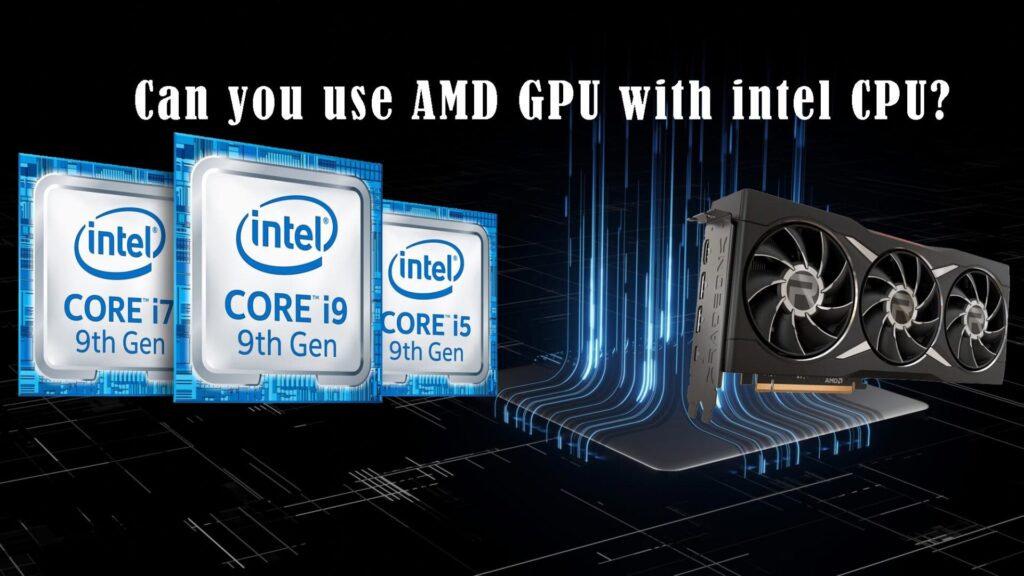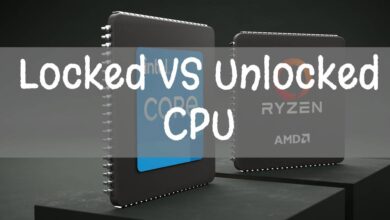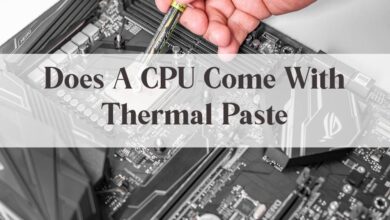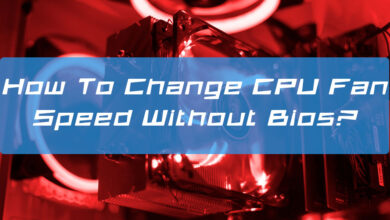Can you use AMD GPU with intel CPU?
Yes! You are on the Right Path! You can use GPU with Intel CPU. Intel’s first Iris Xe desktop graphics cards were released yesterday, but they won’t be found in AMD-powered computers. While Nvidia and AMD’s desktop GPUs are normally compatible with a wide range of Intel and AMD processors, Intel’s new desktop GPUs are now limited.
AMD CPUs and NVIDIA GPUs complement each other nicely. If you acquire a compatible Motherboard, a good Power Supply unit, a desktop case, or a laptop with good thermals and a high-end cooling system, you can use an AMD CPU with an NVIDIA GPU without any performance difficulties.
AMD CPUs are less expensive than Intel CPUs; they have become the new personal choice of gamers. However, due to their superior performance, most gamers favor NVIDIA GPUs over AMD GPUs. As a result, an AMD CPU combined with an NVIDIA GPU would be ideal for a gaming machine. However, a key concern here is whether AMD CPUs can operate with NVIDIA GPUs.
In this article, I’ll discuss why AMD CPUs work with NVIDIA GPUs, their performance levels, and whether AMD CPU and NVIDIA GPU combo are superior to AMD CPU and AMD GPU combination.
The PCIe bus is used to connect CPUs and GPUs. A CPU and GPU must have an architecture that follows the basic norm of PCIe, which is PCI Express x16 architecture in either 3.0 or 2.0 (3rd generation/2nd generation) (3rd generation/2nd generation).
The good news is that Intel, AMD, and NVIDIA all adhere to this stringent restriction, allowing you to employ any combination without issue. An Intel CPU with AMD GPU, an Intel CPU with NVIDIA GPU, an AMD CPU with NVIDIA GPU, and an AMD CPU with an AMD GPU are all possible combinations.
Both AMD and NVIDIA graphics cards now share a similar architecture, with a few minor variances. The Graphics card’s Display Drivers govern the hardware details for each of them when you connect to the AMD GPU or the NVIDIA GPU. As a result, you must keep your graphics card drivers up to date to achieve the best performance.

Article Headings
Is AMD Compatible with NVIDIA?
Absolutely Yes, AMD CPUs work with NVIDIA GPUs if you use a Motherboard that supports the AMD CPU and the NVIDIA GPU, a high-end Power Supply Unit (PSU) that provides adequate power for both the AMD CPU and the NVIDIA GPU to function properly, and a good thermal system and high-end CPU cooling system. The first requirement for the above configuration is a suitable Motherboard.
NVIDIA GPUs are compatible with most AMD Motherboards with a PCIe x16 slot, which means they use the same connection ports. Many gaming motherboards contain a PCI Express x16 slot, which can be either 3.0 or 2.0. Most modern Nvidia GPUs feature PCI Express x16 3.0 interfaces, however, they are backward compatible, therefore a 3.0 can function with a 2.0. As long as you have the newest BIOS and an appropriate PSU wattage, you should be able to install any PCIe graphics card you desire.
The Power Supply Unit comes next (PSU). This is critical because the AMD CPU and NVIDIA GPU require a significant amount of electricity to perform effectively. You’ll need a good power supply that can support both the CPU and the GPU.
Finally, you must choose a desktop case with excellent thermals and a powerful cooling system. If you’re going to use a laptop, make sure to read reviews of the thermals and cooling system.
Benefits of Using AMD GPUs with AMD CPUs
Let’s go over the advantages and disadvantages of choosing an AMD or Nvidia GPU to pair with your AMD CPU to help you decide.
3D Rendering and Workstations
It’s worth noting that AMD’s GPUs are significantly more geared toward gamers. As a result, their features are primarily focused on increasing the number of frames per second (FPS) that the GPU can render.
In comparison to Nvidia’s 2nd generation RT cores, their ray-tracing capabilities are lacking, making them unsuitable for most professional 3D rendering workloads.
Furthermore, the lack of CUDA cores means that many 3D Render Engines, such as Octane and Redshift, is incompatible with these GPUs.
In addition, when it comes to content production and professional editing workloads, AMD GPUs lag behind their Nvidia counterparts significantly. When it comes to GPU effects for DaVinci Resolve, Puget Systems’ benchmarks show the top $999 Radeon RX 6900 XT lagging behind the $399 GeForce RTX 3060 Ti.
Smart Access Memory
AMD’s Smart Access Memory (SAM), which works only between RDNA2 GPUs and Zen 2 or Zen 3 CPUs, is an exclusive feature that requires both an AMD CPU and GPU.
SAM creates a larger data channel by utilizing the CPU PCI Express lanes that the GPU already needs to function. The CPU can access significantly larger temporary assets from the GPU’s VRAM thanks to the enhanced bandwidth provided by the PCIe link.
Open Source Drivers
If you’re using Linux and need graphics-rendering API support, AMD’s GPUs are considerably superior to Nvidia’s. Nvidia deprecated its lone open-source driver (dubbed “NV”) in 2010. AMD’s Catalyst, on the other hand, is up to date and widely available for both Windows and Linux platforms.
Value
The pricing of AMD’s GPUs in comparison to Nvidia’s rivals is a final point to consider. AMD graphics cards can be found to be more cost-effective in many circumstances, depending on the model and task. For example, the Radeon RX 6800 XT exceeds the GeForce RTX 3080 in cost per frame for every resolution evaluated when it comes to gaming performance.
Energy
Some AMD GPUs may work better for your build if performance per Watt is vital for optimizing your setup’s productivity. The RDNA2 Radeon RX 6000 series GPUs were more energy-efficient than equivalently priced Nvidia GPUs, according to Tom’s Hardware benchmarks. Based on performance, the Radeon RX 6800 was shown to be the most power-efficient GPU in these testing.
Conclusion
In the end, whether you have an AMD or Intel CPU makes little difference when it comes to selecting a GPU for your build. Even tiny advantages can go a long way if you want to maximize your PC’s maximum performance for a given task. Graphics processors from AMD and Nvidia are both excellent.
Nvidia has a huge advantage when it comes to 3D rendering and workstation builds. AMD, on the other hand, provides peak 1080p and 1440p performance for dedicated gaming PCs – particularly with the Radeon RX 6900 XT – as well as significantly better cost-per-frame performance for 4K gaming (TechSpot).
FREQUENTLY ASKED QUESTIONS (FAQs)
Can you use an AMD graphics card with an Intel CPU?
At the graphics (GPU) level, Intel and AMD components are interoperable, which means you may buy an Intel motherboard with an Intel CPU and use an AMD Radeon graphics card, such as your i5 and R9 280. With AMD, it’s the other way around.
Which is better Nvidia or AMD?
However, AMD continues to outperform Nvidia in terms of price, although Nvidia has made its price points more accessible and is also releasing costly, high-end GPUs like the new RTX 3080 Ti. The competition between Nvidia and AMD has resulted in some of the greatest and most cheap GPUs we’ve seen in years.
Is AMD faster than Intel?
The issue is much clearer in the non-gaming performance fight between AMD and Intel CPUs. In terms of ultimate performance in threaded productivity and content creation programs, AMD’s highest-end CPUs win outright.









